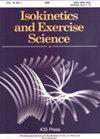Interrelationship between specific high-intensity intermittent efforts ability with aerobic capacity and slow stretch-shortening cycle utilization in taekwondo athletes
IF 0.7
4区 医学
Q4 ENGINEERING, BIOMEDICAL
引用次数: 0
Abstract
BACKGROUND: Repeat high-intensity intermittent efforts is a taekwondo-specific ability but the influence of aerobic capacity and dynamic strength characteristics on this ability has received relatively little attention in the literature. OBJECTIVE: To examine the relationship between specific high-intensity intermittent efforts with aerobic capacity and slow stretch-shortening cycle utilization in taekwondo athletes. METHODS: Nineteen taekwondo male athletes were assessed by squat jump (SJ), countermovement jump (CMJ), 20-meter shuttle run (20MSR), and frequency speed of kick test multiple (FSKTMULT). From the FSKTMULT, total kicks and kick decrement index [KDI] were calculated. Additionally, from both jump tests, the slow stretch-shortening cycle utilization (Slow SSC Utilization) was determined from the eccentric utilization ratio [EUR], pre-stretch augmentation [PSA], and reactive strength index [RSI]. RESULTS: There were positive and significant correlations between total kicks with 20MSR (r= 0.85; p= 0.00) and SJ (r= 0.66; p< 0.05). The multiple regression model demonstrated that total kicks where significantly influenced by 20MSR (R2= 71%; p= 0.00). Additionally, only EUR and RSI explained total kicks performance to a greater proportion (R2= 76%). CONCLUSIONS: The FSKTMULT total kicks performance is positively correlated and influenced by aerobic capacity and slow SSC utilization.跆拳道运动员特定高强度间歇训练能力与有氧能力及慢速缩短周期利用的关系
背景:重复高强度间歇用力是跆拳道特有的能力,但有氧能力和动态力量特征对这种能力的影响在文献中相对较少关注。目的:探讨跆拳道运动员专项高强度间歇运动与有氧能力及慢伸缩短周期利用率的关系。方法:对19名跆拳道男运动员进行深蹲跳(SJ)、反跳(CMJ)、20米穿梭跑(20MSR)和多次踢腿频率速度(FSKTMULT)评定。根据FSKTMULT,计算出总井涌和井涌递减指数[KDI]。此外,从两次跳跃试验中,慢速拉伸缩短循环利用率(慢速SSC利用率)由偏心利用率[EUR]、拉伸前增强[PSA]和反应强度指数[RSI]确定。结果:20MSR总踢次数(r=0.85;p=0.00)与SJ(r=0.66;p<0.05)呈正相关。多元回归模型表明,20MSR对总踢次数有显著影响(R2=71%;p=0.00)。此外,只有EUR和RSI解释了总踢次数的更大比例(R2=76%)。结论:FSKTMULT全踢成绩与有氧能力和SSC利用率呈正相关,并受其影响。
本文章由计算机程序翻译,如有差异,请以英文原文为准。
求助全文
约1分钟内获得全文
求助全文
来源期刊

Isokinetics and Exercise Science
医学-工程:生物医学
CiteScore
1.20
自引率
14.30%
发文量
37
审稿时长
>12 weeks
期刊介绍:
Isokinetics and Exercise Science (IES) is an international journal devoted to the study of theoretical and applied aspects of human muscle performance. Since isokinetic dynamometry constitutes the major tool in this area, the journal takes a particular interest in exploring the considerable potential of this technology.
IES publishes studies associated with the methodology of muscle performance especially with respect to the issues of reproducibility and validity of testing, description of normal and pathological mechanical parameters which are derivable from muscle testing, applications in basic research topics such as motor learning paradigms and electromyography. The journal also publishes studies on applications in clinical settings and technical aspects of the various measurement systems employed in human muscle performance research.
The journal welcomes submissions in the form of research papers, reviews, case studies and technical reports from professionals in the fields of sports medicine, orthopaedic and neurological rehabilitation and exercise physiology.
 求助内容:
求助内容: 应助结果提醒方式:
应助结果提醒方式:


